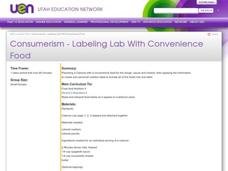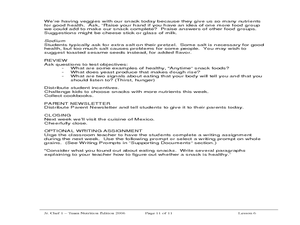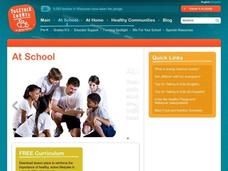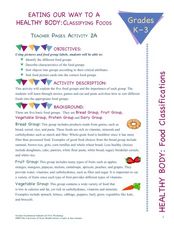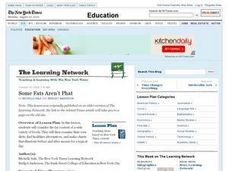Curated OER
Consumerism - Labeling Lab With Convenience Food
Students examine the differences between convenience food and food that has to be prepared in order to use it in another recipe. In groups, they make a calzone using only convenience food. After baking, they work together to make their...
Curated OER
Energy Plus!
"Energy Plus!" from Together Counts is three days worth of lessons, discussions, and activities about nutrition. The materials help you teach youngsters about eating healthy and burning calories. Energy in and energy out. Included are...
Curated OER
Nutrition and the Media: Cereal Box Consumerism
How many treats do you buy each week? Learners investigate diets and how the media tricks consumers into purchasing unhealthy snacks. They will investigate the designs and logos affiliated with cereal boxes and identify specific phrases...
Curated OER
Happy Mealtimes
Students read The Hungry Caterpillar to examine healthy eating habits. In this food and nutrition lesson, students role play the various responsibilities during family mealtime. They will discuss the struggles of healthy eating, and the...
Curated OER
Agriculture: It Doesn't Just Happen
After reading an informational text on the Agricultural Research Service, learners research the role of the ARS in Oklahoma. Using reputable online sources, they label a map of the state with relevant areas. Researchers focus on one of...
Captain Planet Foundation
George Washington Carver and the Sweet Potato
Learn about George Washington Carver's important contributions to agriculture by studying the sweet potato. First graders read about the inventor's observations and prepare sweet potato slips for the class garden. Additionally, they...
Curated OER
Food Labels in the Classroom
Students read all information given on packaging; write down complete ingredients and grams of protein, carbohydrates and fat per serving. They compare the information with current health references and write a business letter to a food...
Curated OER
Nutrition
Students examine nutrition and their own eating habits. For this healthy eating lesson students participate in several activities that include building a food pyramid and analyzing it.
Curated OER
Nutrition Unit
First graders complete activities for the six basic food groups. In this food groups lesson, 1st graders view examples of food samples from the various groups and sample the foods. Students discuss the food pyramid and draw a fruit or...
Curated OER
Dribbling for Nutrition
Students practice reading food labels and determining the correct number of grams of fat and carbohydrates in a single serving. They work on improving dribbling skills during the task.
Curated OER
Sugar-Coating the Facts
Students explore the food industry's influence on American Student nutritional habits and analyze the nutrition charts found on food packaging. They design their own warning labels for foods targeted at Students.
Curated OER
Bizarre Food
Students research foods from other countries. In this multicultural food lesson, students view a list of foods that kings and queens ate on an overhead transparency and go to the website www.jamessolheim.com/teachers1.htm to read about...
Curated OER
Kool Kumara Lesson Plans - Healthy Living
Students read graphs as they work with recommended daily intakes of nutrients. For this math and nutrition lesson, students examine Recommended Daily Intake Maps to establish how much of the daily requirement is met by eating on kumara....
Curated OER
Jr. Chef Club Super Snacks Lesson 6
Students explore healthy snacks. In this nutrition and cooking lesson, students observe and identify food groups on USDA's MyPyramid food guide. Students discuss how fiber helps our digestive system and follow a recipe using yeast to...
Curated OER
Health: Diet and Nutrition
Students access a variety of nutrition and health related resources on the Internet. They examine the food pyramid, match food groups, play interactive games, read an online story, analyze the labels on food packaging, and take a...
Curated OER
Reading Food Labels
Students investigate the concept of phonemic awareness in order to help increase reading comprehension. The reading of food labels creates the context for the practice session. They pay particular attention to certain sounds that must be...
Curated OER
Energy Plus!
This lesson seems pretty advanced for K-2nd graders, but there are some pieces that can be used with young learners. Look through this comprehensive, fact-filled lesson and pull out information and activities that you can adapt to fit...
Curated OER
When Something's Missing: Diagnosing Vitamin Deficiencies
The New York Times "Education" section posts an extensive lesson on vitamin and mineral deficiencies. It involves class discussion, examination of food packaging labels, and the reading of a blog post about Vitamin D. The highlight of...
Curated OER
ESOL Consumer Education
Students discuss the importance of reading and understanding price
tags, labels and expiration dates. They Compare/contrast the significance and practice of reading food labels, expiration dates and prices of food items in students'...
Curated OER
Get the Skinny on Milk
Students identify the different types of milk available in the market. In this adult health science lesson, students compare their nutrition information. They read milk labels and analyze the nutrients in it.
Curated OER
Jr. Chef Club Making Brainy Breakfasts
Young scholars identify the benefits of eating a nutritious breakfast. In this nutrition lesson, students read food labels to identify foods that are low in sugar. Young scholars create a healthy breakfast by using eggs and low-fat cheese.
Curated OER
Eating Our Way to a Healthy Body: Classifying Foods
Students examine the major food groups. In this classifying foods lesson, students discover the 5 food groups as they read books and play games. Students then sort foods into the appropriate food groups
Curated OER
Some Fats Aren't Phat
Students examine nutritional information on various food labels and then consider the nutritional value of the foods in their own diets. They create posters illustrating their diets "before" and "after" they considered their fat intake.
Curated OER
"Mush Lab"
Learners use the information they learned from reading food labels to create mush meals. They blend unlikely meals together to form the mush and then evaluate its nutritional value. They examine their own eating habits after the lab is...


